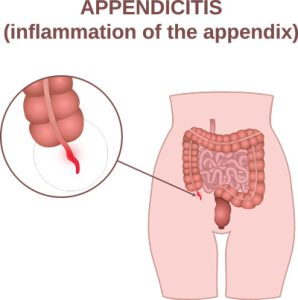Services
Appendix Surgery

What is appendicitis?
Appendicitis is an inflammation of the appendix, which is a small pouch (two to four inches long) of tissue attached to the colon, located in the lower right abdomen. It is formed at the junction of the small and large intestines.
What are the symptoms of appendicitis
A sudden pain that comes and goes around the middle of the abdomen and then moves to the lower right abdomen becoming constant and severe, or a pain in the lower right abdomen (where the appendix is located), are common symptoms of appendicitis. Pressing on the affected area, coughing, or walking can worsen the pain.
Other symptoms include nausea, vomiting, loss of appetite, diarrhoea, abdominal swelling and a fever. For pregnent women, pain can arise from the upper part of the abdomen, because the appendix will be located higher up during pregnancy.
An intense pain that eases but then becomes worse all of a sudden and spreads across the abdomen, is a sign that the appendix may have burst (ruptured). This can happen 48 to 72 hours after the start of symptoms and requires immediate medical attention.
What causes appendicitis?
Appendicitis is caused by a blockage or obstruction in the appendix – due to faeces, bacteria, or even a tumour – that leads to inflammation and infection. The appendix gets filled with a build-up of mucus, causing swelling and the formation of pus.
This is a common condition that affects around 233 people per 100,000 population each year in India alone. Even though anyone can develop appendicitis, it is more frequent among people aged 10 to 30 years old. Men and people with a family history of appendicitis are also at an increased risk.
How is appendicitis diagnosed?
It is difficult to diagnose appendicitis. This is because symptoms can be undefined, and similar to other gastrointestinal conditions or ovarian disorders .
However, there are several tests that can help to diagnose a case of appendicitis:
- Urine test, to rule out kidney stones or a urinary tract infection
- Blood test to check for signs of infection
- Ultrasound Abdomen
- Few Patients may need CT Abdomen
Early diagnosis and treatment are crucial. If you develop any symptoms of appendicitis, you should see a doctor immediately. Avoid foods, drinks, heating pads, and pain relief medication.
How can appendicitis be prevented?
Appendicitis is very hard to prevent, although there is evidence that it is less prevalent in people with high fibre diets (whole grains, fresh fruits and vegetables).
Appendicitis can lead to the appendix rupturing, which is a very dangerous complication, and it is important to prevent the condition reaching this stage. A ruptured appendix spreads potentially life-threatening infection through the abdomen.
Peritonitis occurs when the peritoneum (tissue which lines the abdomen) becomes infected, which can cause long-term problems, and even death. If you develop peritonitis, you will need surgery to remove the appendix and clean the abdominal cavity.
What is the treatment for appendicitis?

In most cases of appendicitis, the appendix will need to be removed as soon as possible, by surgery. The operation is referred to as an appendectomy and is performed to prevent the appendix from bursting. An appendectomy is performed as either open or laparoscopically (keyhole surgery).
Laparoscopic surgery is preferred over open surgery and will be carried out where possible. Laparoscopic surgery is less invasive than open surgery and has shorter recovery times. Several small incisions are made in the abdomen, which is then inflated with a gas to make it easier to perform the surgery. The operation is done with the aid of a laparoscope, which is a small tube with a camera that relays images back to the surgeon.
In cases where the patient has previously had abdominal surgery or the appendix has already burst, it might not be possible to perform keyhole surgery. In these cases, open surgery might be preformed, which consists of a single, larger cut in the lower right abdomen.
If the appendix has burst and an abscess has formed in the abdomen, it will be necessary to drain the abscess before performing an appendectomy. A surgeon will either drain the fluid right away or place a tube through the abdominal wall into the abscess, leaving it in place for two weeks. During that time, antibiotics will be prescribed to fight the infection. Once there is no sign of infection, abdomen drain will be removed. You will have surgery to remove the appendix after 3-4 weeks from day of onset of symptoms.
The appendix has no known purpose. Its removal will not affect your health or your quality of life.
What is the recovery like?
If you have had keyhole surgery, you may be able to go home within 24 hours or a day after the surgery.
Feeling some pain and bruising in the first few days after the operation is normal, and will improve over time. Most people will be able to return to their usual normal activities in two to three weeks.
With open, or a complicated surgery, you will need more time to recover. Your hospital stay will be closer to a week, and making a full recovery may take six weeks or longer.
When to Call ?
Contact us if you experience:
- Bleeding
- Increasing abdominal swelling
- Pain that is not relieved by your medications
- Persistent nausea or vomiting
- Chills
- Persistent cough or shortness of breath
- Purulent drainage (pus) from any incision
- Redness surrounding any of your incisions that is worsening or getting bigger
- You are unable to eat or drink liquids
- Persistent fever over 101 degrees F (39 C)

